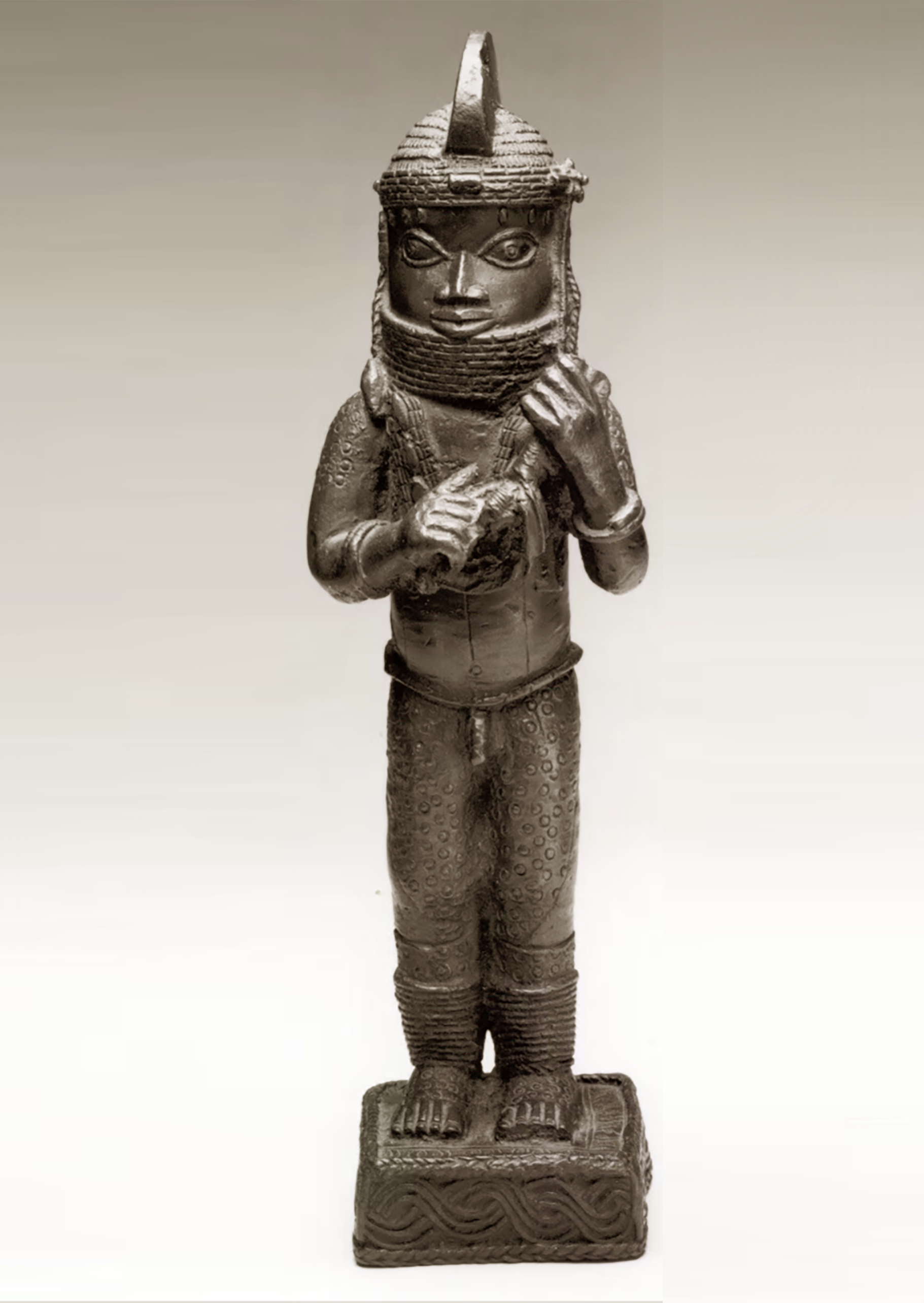Galerie Wolfgang Jaenicke
A rare Ibierugha
A rare Ibierugha
Couldn't load pickup availability
A rare Ibierugha (attendant figures) sculpture with a Sword or Eben inIbierugha the left hand. Probably it is a fragmentary, slightly bent Eben, whose lower part is no longer existing. The left foot is nearly broken at the level of the toes. endigmatic, which the figure carries in its right hand. Digital Benin knows only 11 exeplares.
Ibierugha are in the first stage of being initiated into chieftaincy. They are wearing the Odigba, which is the bead collar worn by the Ọba and chiefs, and have a distinctive hairstyle or headdress which would have been the fashion for chiefs.
An Ibierugha sculpture collected by Mert Simpson (1928 – 2013) shows a fragmentary Eben, where the upper part is missing, but the lower part is intact.
Ibierugha are either carved in ivory or cast in brass/bronze. As with much of Benin art, they are not portraits of specific people, but depict in a general manner attendants who would have served the Ọba. The boys or men all wear a distinctive headdress or hairstyle with a raised section down the centre part. The figures are often naked except for a beaded string or girdle around the waist or hips, and they often wear a beaded choker which can only be worn by an individual of high rank in the court. The figures usually stand on top of square bases decorated with low relief guilloche motifs: Source Digital Benin
igures of the Ibierugha, the titled courtiers and officials of the Benin Kingdom, are generally depicted not with swords, but with eben—the flat, leaf- or fan-shaped emblems made of ivory or brass. The eben functions as a symbol of loyalty, dignity, and rank, and is held in the right hand or waved before the face during ceremonial occasions.
Swords—especially the ada or eben-ada types—appear primarily in depictions of warriors or in compositions that emphasize martial power, often in association with the Oba or commanders of the military guilds.
Thus, in Benin court iconography, the presence of the eben distinguishes the Ibierugha as civil and ceremonial officials, whereas the sword identifies figures connected with warfare and royal authority.
Depictions of Ibierugha figures from the Benin Kingdom are generally clothed, typically wearing ornamented court garments. These consist of wrapped cloths or aprons (ukpo), often elaborately patterned and secured with belts or beadwork. They also display bead necklaces, bracelets, and anklets, signifying rank and proximity to the Oba.
While the upper body may sometimes appear bare, this reflects an artistic convention rather than actual nudity, emphasizing vitality, dignity, and controlled strength. Fully nude figures are not characteristic of Ibierugha representations; their dress and regalia clearly identify them as members of the courtly hierarchy, distinct from servants, attendants, or lower-ranking warriors.
Paula Ben-Amos, The Art of Benin (London: Thames and Hudson, 1980).
Barbara Plankensteiner (ed.), Benin – Kings and Rituals: Court Arts from Nigeria (Vienna: Museum für Völkerkunde / Snoeck, 2007).
Kathleen Bickford Berzock and Barbara Plankensteiner (eds.), Benin: Royal Arts of a West African Kingdom (Chicago: The Art Institute of Chicago, 2008).
Philip J. C. Dark, An Introduction to Benin Art and Technology (Oxford: Clarendon Press, 1962).
Kathryn Wysocki Gunsch, The Benin Plaques: A 16th-Century Imperial Monument (New York: Routledge, 2018).
Ezra, Kate, Royal Art of Benin: The Perls Collection in The Metropolitan Museum of Art (New York: Metropolitan Museum of Art, 1992).
William Fagg, Nigerian Images (London: Lund Humphries, 1963).
Height: 66 cm
Weight: 10,8 kg












































